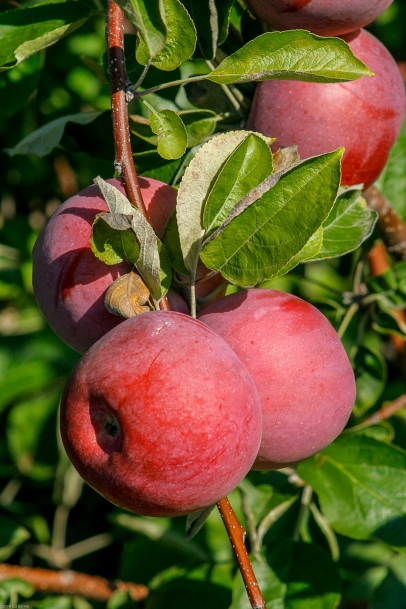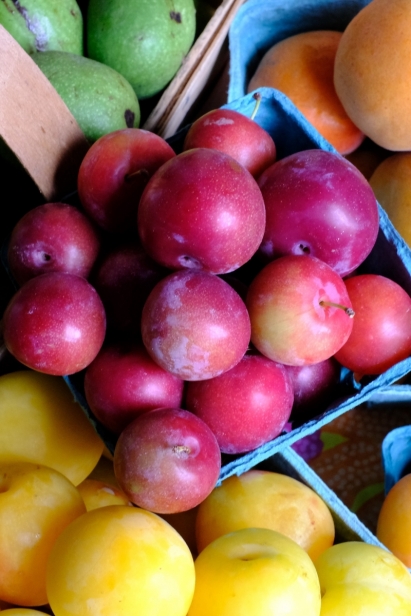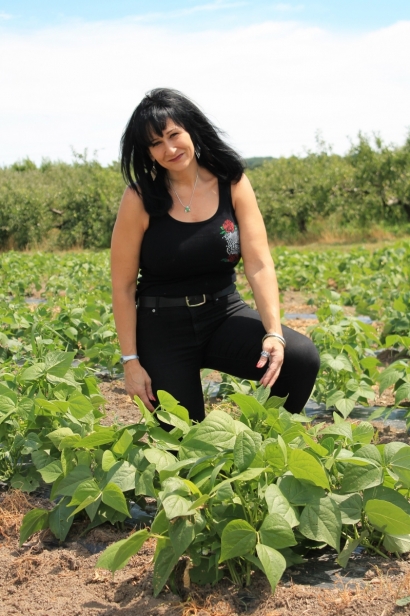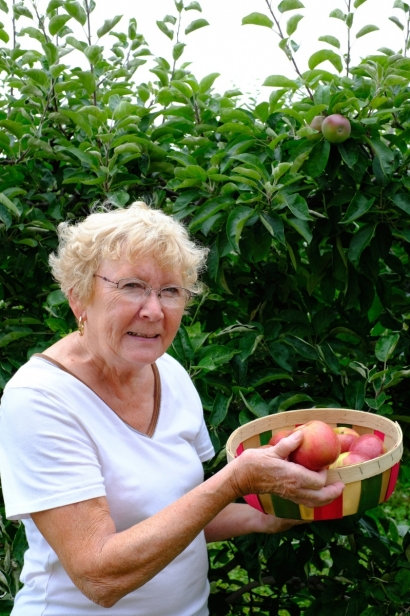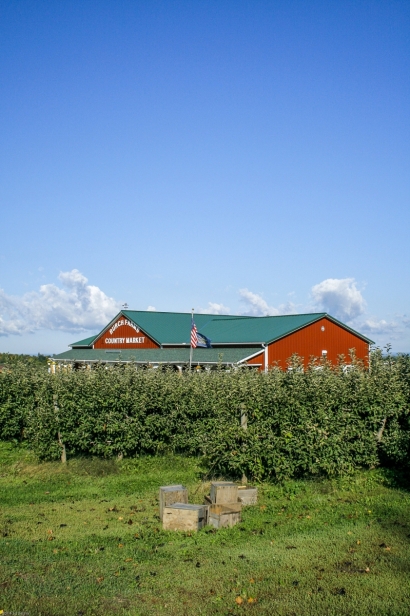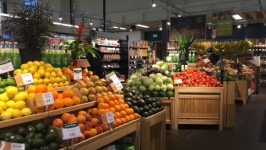Promoting our Love for Local
At a mindfulness workshop a few years ago, we were each given a grape. Our instructions were to roll it between our fingers, becoming fully aware of its texture, color, shape and scent.
I’d just finished Vicki Robin’s wonderful Blessing the Hands that Feed Us, in which she recounts living for a month on only what had been grown or raised within 10 miles of her Whidbey Island, Washington, home. I couldn’t help but imagine how far the grape had traveled to arrive at a mindfulness workshop in Erie. I had no idea who picked it, who tended its vines, or how long it had been since it drew succulent sugars and vital nutrients from sun and soil.
Eventually, we were told to eat the grape—slowly. My mind said “grape” to my taste buds, but they weren’t convinced. It tasted dead, and that mindfulness stuff had me so emotionally tuned that I actually started to cry. “Wow,” whispered my husband, “that was some grape you got.”
Unfortunately, that grape is typical of our food system. So much of what we eat—even those of us who champion local food—has anonymous roots. Plus, the word “local” can be deceiving. The U.S. government defines a product as “local” if it’s marketed less than 400 miles from its origin, or within the state where it’s produced. So, in Erie, I could be sold “local” food from Philadelphia, Washington, D.C., or Lexington, Kentucky.
Of course, food can’t travel far without some creative tactics. Tomatoes are picked and packaged green while globetrotting apples sleep for a year in cold storage, and “fresh” loses meaning by the mile.
I know how weary I feel after a long trip. How much life could be left in that food?
Virtually none compared, for instance, to the wondrous blueberries from Rahal Farms I’ve bought at Erie’s Whole Foods Co-op. Kiya Rahal said they’re not distributed until they “have the sugar.” Those berries pulse with life.
Kiya’s dad, Wajeeh Rahal, started the North East farm in 1972 after immigrating from Lebanon. The family has relied on the pick-your-own venue for over 20 years, especially as grapes became less economically sustaining.
They also sow an 8-acre garden with produce integral to Middle Eastern cuisine, including eggplant, cucumbers, beans, cusa squash, and other seeds from Lebanon. Wajeeh has even grown kiwi, goji berries and figs. They sell their produce in Cleveland near Aladdin’s, Kiya’s uncle’s bakery, and at other Middle Eastern stores. They also supply to Edible Earth Farm’s CSA in Pennsylvania and CHQ Local Food in New York.
Without major advertising, this market diversity, Facebook and word of mouth have helped to sustain Rahal Farms. They’ve built a client base of 1,500 customers, with the sort of personal loyalty essential to non-corporate enterprises.
Kiya noted that people are more conscientiously seeking out smaller farms. She talked about those who have been coming to the farm for 40 years, looking forward to seeing her octogenarian dad. And she described watching her kids collect the farm’s fresh produce and eggs, then devour the wonderfully nutritious bounty.
“I just get goosebumps,” she told me. “It’s a very fulfilling, beautiful life. But it’s very hard work.”
Last year, Rahal Farms lost 40 percent of their grape income because their buyer decided to exercise a small contract stipulation. “It was a huge blow, and we had no recourse,” Kiya said.
During the 2017 spring monsoon-like weather, Rahal Farms lost many cherries. Though farmers carry insurance to protect against crop loss, Kiya said they’ll only recoup about 5 percent of their expected income from the policy.
Cost has also prevented this almost entirely no-spray farm from obtaining organic certification. “But we’re as natural as we can be,” she added.
And when non-sprayed cherries endure excessive rain, they can crack, causing some farm visitors to reject them. “Natural fruit might not look perfect,” Kiya explained. “But it’s the sugar that cracks it. You just can’t let them sit as long.”
Educating a public accustomed to imported produce is a major role for local growers, and one that Tim Burch, owner of Burch Farms in North East, PA, has embraced wholeheartedly.
A sixth-generation farmer, Burch said that although he is the largest apple grower in Erie County, PA, he’s a “backyard gardener” on the U.S. scale, mentioning for contrast a larger competitor’s $25,000 campaign to promote Washington State apples to one regional grocery store.
Last spring, the Erie Times-News reported that Burch removed nearly 11,000 apple trees “because he said he can no longer afford to produce so much of the fruit. Burch sold 14,000 bushels of last year’s crop to a Buffalo, New York, juicer who paid him $3 a bushel, far less than the $10 a bushel Burch says it cost him to grow the fruit.”
Farmers often harvest copious amounts of crops only to find that their major buyers have disappeared. Burch imagines that in the next few years, there could be little to no local produce in our grocery stores. “But don’t talk to me,” he added emphatically, “talk to them about it.”
Burch Farms hosts field trips for local students, and Burch is troubled by how little understanding there is about our food’s origins. “It breaks my heart to think someone’s not educated about where fruit comes from.”
And many of us are unaware of what local farmers are truly facing. Burch mentioned several farms currently for sale in North East Township. “If farmers don’t buy them,” he explained, “developers are going to plant houses. And that land won’t return to agriculture.”
Also a grape farmer, Burch said that a nationwide supply surplus is killing the marketplace. Two years ago, he would get $240 per ton for his crops. Now it is only about $117 per ton. It’s the same glut of the market affecting apples.
He pointed out that pediatricians encourage parents not to feed children fruit juices as an anti-obesity measure. But, he clarified, natural sugars can be good. Meanwhile, energy drink consumption is skyrocketing.
Nutritionists agree that the natural nutrients absorbed through eating truly fresh produce are essential to immunity, organ development and overall health. “But we’ve gotten so far away from that,” Burch explained. “You cannot ship strawberries from California to the East Coast with the nutritional value of a local vine-ripened strawberry. And it’s the consumer who has the biggest loss.”
But both consumers and growers win when we’re loyal to local food. Long-distance produce can’t hold a candle to a crisp McIntosh apple from Burch Farms, brightly balanced with sweet/tart contrasts, or indulgently juicy plums from Rahal Farms, picked precisely at their peak.
The enthusiasm behind the local foods movement is heartening. But it’s essential that those of us who celebrate the superior flavor, nourishment and ethics of local food let our grocery stores and markets know that we are willing to pay for high quality food raised by our neighbors.
And while farmers’ markets and farm stands are still well-stocked, our activism is even easier. Dollars delivered directly to local farmers mean better communities and environments for all of us. From keeping land in agriculture to ensuring ecological sustainability, it’s hard to imagine a more impactful way to create the sort of healthy, egalitarian and empowered region we want to live in.
But it’s up to all of us to help get that message across. “You have to tell somebody,” says Tim Burch. “You have to spread the word.”
> Rahal Farms: 8200 Bort Rd, North East, PA; 814-725-1257
> Burch Farms Country Market: 9210 Sidehill Rd, North East, PA; 814-725-0747


